
Witty comedy, incisive social commentary, unconventional love story, and the inspiration for what many consider the greatest Broadway musical ever—George Bernard Shaw’s Pygmalion is all this and (as revived for a 21st-century audience at the Pasadena Playhouse) much, much more.
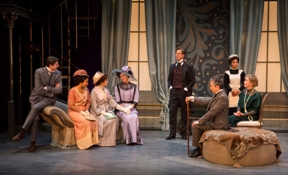 Playhouse-goers familiar only with Alan Jay Lerner and Frederick Lowe’s My Fair Lady can look forward to experiencing both the pleasure of recognition and the joy of surprise in Shaw’s original song-free play.
Playhouse-goers familiar only with Alan Jay Lerner and Frederick Lowe’s My Fair Lady can look forward to experiencing both the pleasure of recognition and the joy of surprise in Shaw’s original song-free play.
Like Lerner and Lowe’s musical, Pygmalion opens with phonetics professor Henry Higgins (Bruce Turk), his soon-to-be bestie Colonel Pickering (Stan Egi), wealthy young man-about-town Freddy Eynsford-Hill (Alex Knox), Freddy’s hoity-toity mother (Lynn Milgrim), and most importantly Cockney flower girl Eliza Doolittle (Paige Lindsey White) in Covent Garden just after an evening of theater for all but Miss Doolittle, whose “cold-blooded murder of the English tongue” (I’m quoting Lerner and not Shaw here) sets Professor Higgins to jotting down her maimed consonants and mangled vowels for later study.
As anyone familiar with either the “Julie Andrews musical” or the “Audrey Hepburn film” can tell you, this first meeting has Rex Harrison (sorry, make that Henry Higgins) making Colonel Pickering a life-changing proposition: “In three months I could pass that girl off as a duchess at an ambassador’s garden party. I could even get her a place as a lady’s maid or shop assistant, which requires better English.”
The professor’s modus operandi is as one-pronged as modi operandorum can get. Simply teach Eliza proper English pronunciation and she can do pretty much anything her heart desires.
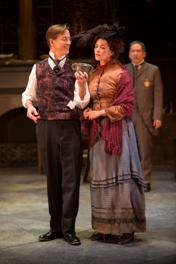 As in My Fair Lady, Eliza decides to take Higgins up on his offer by arriving unannounced at his Wimpole Street residence for said lessons, the professor then wagers the colonel that he can make good on his previous proposition, and Eliza’s dustman father Alfred P. Doolittle (Time Winters) shows up soon after to buy his daughter back and (however unintentionally) to impress Henry Higgins with his unorthodox views on morality.
As in My Fair Lady, Eliza decides to take Higgins up on his offer by arriving unannounced at his Wimpole Street residence for said lessons, the professor then wagers the colonel that he can make good on his previous proposition, and Eliza’s dustman father Alfred P. Doolittle (Time Winters) shows up soon after to buy his daughter back and (however unintentionally) to impress Henry Higgins with his unorthodox views on morality.
From here on in, Pygmalion takes off on its own, deepening relationships, providing social commentary not in My Fair Lady, focusing more on certain characters and less on others, and most importantly, allowing us to feel the depth of the romantic, sexual chemistry lurking just under the surface of Henry and Eliza’s teacher-student relationship—or at least the latter is the case at the Playhouse under Jessica Kubzansky’s inspired direction.
Lerner and Lowe’s particular brilliance was in allowing their songs to give us insight into characters permitted to sing their feelings, Eliza’s “Wouldn’t It Be Loverly?” and “I Could Have Danced All Night” and Henry’s “I’m an Ordinary Man” and “I’ve Grown Accustomed to Her Face” chief among these sung soliloquies.
Shaw’s original 1913 play makes us work harder at understanding Pygmalion’s two leads, in addition to requiring us to fill in blanks between scenes. We see nothing at all of Eliza’s phonetics lessons (no “The Rain In Spain” here), though Kubzansky does give us some audio hints of those lessons during a set change. There is no Embassy Ball either, merely Henry’s, Pickering’s, and Eliza’s reactions to its successful outcome. My Fair Lady fans may carp, but this reviewer for one found significant fascination is seeing how well Shaw’s play works without these scenes.
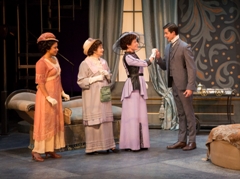 Though we are given considerably less of Freddy, we do get to spend more time with Mrs. Eynsford-Hill and with Freddy’s sister Clara (Carolyn Ratteray), ignominiously excised from My Fair Lady, and most significantly with Eliza’s “undeserving poor” dad. And though Eliza’s famous “Them as pinched it done her in” scene takes place in Mrs. Higgins’ drawing room and not at the Ascot Racecourse (another reason My Fair Lady fanatics might grumble), Shaw milks Eliza’s “small talk” (and the Eynsford-Hills’ assorted reactions to it) to even more delightful effect than Lerner and Lowe did.
Though we are given considerably less of Freddy, we do get to spend more time with Mrs. Eynsford-Hill and with Freddy’s sister Clara (Carolyn Ratteray), ignominiously excised from My Fair Lady, and most significantly with Eliza’s “undeserving poor” dad. And though Eliza’s famous “Them as pinched it done her in” scene takes place in Mrs. Higgins’ drawing room and not at the Ascot Racecourse (another reason My Fair Lady fanatics might grumble), Shaw milks Eliza’s “small talk” (and the Eynsford-Hills’ assorted reactions to it) to even more delightful effect than Lerner and Lowe did.
Minus songs, Pygmalion can get rather wordy (it is George Bernard Shaw after all), but compared to other Shavian works I’ve seen, this is the playwright’s least talky comedy, and the words are delicious mouthfuls indeed.
All of this is reason to see just about any Pygmalion revival if only for curiosity’s sake. Since the Pasadena Playhouse has secret weapon Kubzansky in the director’s chair, there are considerably more reasons to catch Pygmalion at the Playhouse than mere curiosity.
Whether World Premiere or Classical Revival, Kubzansky (like any great director) begins with the text, even if this means disregarding certain “stage directions,” often a playwright’s sneaky method of getting his own way. Have Henry and Eliza say their lines at a comfortable distance from each other and you get an entirely different scene than by placing them only inches apart, which is where Kubzansky situates the couple after Eliza wins Henry his bet. Most significantly, without changing a word of dialog, Kubzansky gives us a devastating new take on Pygmalion’s final moments, one that reveals just how much director and cast have discovered in Shaw’s words—and in the unspoken language lying under the surface.
It’s hard to imagine two more superb performances than those given by Turk and White, who take characters that have become indistinguishable from the actors who brought them to life on musical stage and screen, and make them entirely their own.
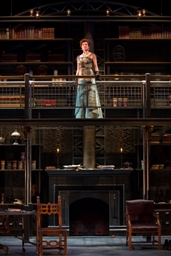 The always extraordinary White gives us an Eliza so “deliciously dirty” (and grittily earthy) in her early scenes that her transformation from guttersnipe to goddess is a thing of beauty to behold. As for Turk’s Henry, the cold, arrogant surface he reveals in Act One makes the depth of what actor and director reveal in Act Two all the more powerful. I’ve seen Eliza and Henry’s post-ball confrontation many times (albeit in My Fair Lady mode) but no two actors have ever moved me as Turk and White do here, and to say that their final scene will have you on the edge of your seat is an understatement.
The always extraordinary White gives us an Eliza so “deliciously dirty” (and grittily earthy) in her early scenes that her transformation from guttersnipe to goddess is a thing of beauty to behold. As for Turk’s Henry, the cold, arrogant surface he reveals in Act One makes the depth of what actor and director reveal in Act Two all the more powerful. I’ve seen Eliza and Henry’s post-ball confrontation many times (albeit in My Fair Lady mode) but no two actors have ever moved me as Turk and White do here, and to say that their final scene will have you on the edge of your seat is an understatement.
Egi makes for an endearingly fussy Colonel Pickering, Milgrim brings her own distinctively dithery persona to a marvelous Mrs. Eynsford-Hill, and Ratteray is a delightful Clara, and proof that daughters could have as much a mind of their own a century ago as today. As for Knox’s Freddy, the talented young leading man makes the debonair gent such a dashing charmer that one can’t help wishing Mr. Eynsford-Hill were given the stage time afforded him by Lerner and Lowe.
Mary Anne McGarry is pure perfection as Mrs. Higgins, Henry’s loving albeit not always approving mother, and Ellen Crawford too could not be better as housekeeper Mrs. Pearce.
Sarah Hollis, Tom Shelton, and Greg Watanabe ably fill various cameo roles as theatergoers, servants, and assorted Londoners, though without My Fair Lady’s multiple ensemble numbers (“Wouldn’t It Be Loverly,” “With A Little Bit Of Luck,” and “Ascot Gavotte” to name just three), Shaw gives them a good deal less to do than Lerner and Lowe.
Last but not least is Winters’ scene-stealing Alfred P. Doolittle, arguably the character most distinctively treated in play and musical. My Fair Lady has him mostly in comic-relief/song-and-dance mode. Pygmalion gives the philosophical dustman considerably more meat, and Winters is a wonder in the role.
(That the racial diversity exhibited on the Pasadena Playhouse stage is an example more theaters ought to follow should go without saying, but still needs to be said … and emulated. Kudos to Kubzansky, to casting director Julia Flores, and to artistic director Sheldon Epps for giving us more of what we ought to be seeing all the time on our stages large and small.)
Pygmalion has been brought to stunning visual/audio life by scenic designer Stephanie Kerley Schwartz, costume designer Leah Piehl, lighting designer Jaymi Lee Smith, composer Bruno Louchouarn, and wig/hair designer Carol F. Doran, with special snaps to animator Kaitlyn Pietras for reminding us that Pygmalion is about the power of words and how we say them. Dialect coach Nike Doukas deserves special mention for the same reason.
Hethyr “Red” Verhoef is production stage manager, Jessica R. Aguilar is stage manager, Kirsten Hammack is producing associate/company manager, Brad Enlow is technical director, and Joe Witt is general manager/production manager.
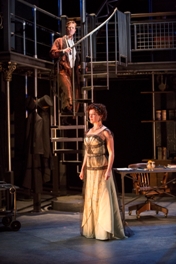 No matter how many times you’ve seen My Fair Lady, do yourself a favor and see Pygmalion at the Pasadena Playhouse. Go with an open mind, since Shaw’s play is not “the musical without the songs,” but by all means go. Particularly as re-envisioned by Jessica Kubzansky and brought to life by an all-around sensational cast and design team, George Bernard Shaw’s Pygmalion is a work that stands very much on its own—and like its particularly statuesque cast, stands tall indeed.
No matter how many times you’ve seen My Fair Lady, do yourself a favor and see Pygmalion at the Pasadena Playhouse. Go with an open mind, since Shaw’s play is not “the musical without the songs,” but by all means go. Particularly as re-envisioned by Jessica Kubzansky and brought to life by an all-around sensational cast and design team, George Bernard Shaw’s Pygmalion is a work that stands very much on its own—and like its particularly statuesque cast, stands tall indeed.
Pasadena Playhouse, 39 South El Molino Ave., Pasadena.
www.pasadenaplayhouse.org
–Steven Stanley
March 22, 2015
Photos: Jim Cox
Tags: George Bernard Shaw, Los Angeles Theater Review, Pasadena Playhouse



 Since 2007, Steven Stanley's StageSceneLA.com has spotlighted the best in Southern California theater via reviews, interviews, and its annual StageSceneLA Scenies.
Since 2007, Steven Stanley's StageSceneLA.com has spotlighted the best in Southern California theater via reviews, interviews, and its annual StageSceneLA Scenies.







 COPYRIGHT 2024 STEVEN STANLEY :: DESIGN BY
COPYRIGHT 2024 STEVEN STANLEY :: DESIGN BY